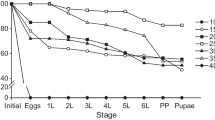Abstract
Effect of constant temperatures viz, 18 ± 1, 21 ± 1, 24 ± 1, 27 ± 1, 30 ± 1 and 33 ± 1 °C was studied on the egg, larval and pupal development of Sesamia inferens. Development rate of egg, larva and pupa gradually increased with increase in temperature, while total developmental period decreased. Mean developmental period of the pest decreased from 116.6 days at 18 ± 1 °C to 31.8 days at 33 ± 1 °C. The lowest and the highest temperatures at which no development took place were found to be 9 ± 1 and 39 ± 1 °C, respectively. Regression equations between development rate and temperature were found to be Y = 0.021X–0.290 (R2 = 0.94) for egg; Y = 0.002X–0.020 (R2 = 0.92) for small larva (1st–3rd instar); Y = 0.005X–0.056 (R2 = 0.76) for large larva (4th–5th instar) and Y = 0.006X–0.076 (R2 = 0.89) for pupa, respectively. Thermal constant for egg, small larva, large larva and pupa were determined as 47.6, 500.0, 200.0 and 166.7 degree days (DD), respectively with corresponding development threshold being 13.8, 10.0, 11.2 and 12.7 °C. Thermal constant to complete a generation was found to be 874.3 DD.




Similar content being viewed by others
References
Pathak MD, Khan ZR (1994) Insect pests of rice. International Rice Research Institute, P.O. Box 933, Manila, Philippines
Singh B (2012) Incidence of the pink noctuid stem borer, Sesamia inferens Walker on wheat under two tillage conditions and three sowing dates in North-Western plains of India. J Entomol 9:368–374
Katti G (2009). Changing pest scenario and management of emerging pests in rice ecosystem. In: Babu TR, Reddy KD, Rao SRK, Umamaheshwari T, Sridevei D (eds) Proceeding of summer school on changing insect pest scenario and management strategies in different crops. Acharya NG. Ranga Agricultural University. pp 36–39
Kushwaha KS, Bharti LR (1994) Insect-pests of rice and their management. Proceedings of National Symposium on rice-wheat system for sustainable productivity. 7–8 May 1994. Karnal RRS, India, p 167–173
Catling HD, Islam Z, Pattrasudhi R (1987) Assessing yield losses in deepwater rice due to yellow stem borer, Scirpophaga incertulas Walker in Bangladesh and Thailand. Crop Prot 6(1):20–27
Trudgill DL, Honek LD, Van Straalen NM (2005) Thermal time-concepts and utility. Ann Appl Biol 146:1–14
Urra F, Apablaza J (2005) Threshold temperature and thermal constant for the development of Copitarsia decolora (Lepidoptera: Noctuidae). Cien Inv Agr 32(1):16–23
Uvarov BP (1931) Insects and climate. Trans Entomol Soc Lond 79:1–247
Zalom FP, Goodell L, Wilson W, Bentley W (1983) Degree days: the calculation and use of heat in pest management. Division of agricultural and natural resources, University of California, Davis, CA, USA, p 10
Messenger PS (1958) Bioclimatic studies with insects. Annu Rev Entomol 4:183–206
Kipyatkov VE, Lopatina EB (2010) Intra-specific variation of thermal reaction norms for development in insects: new approaches and prospects. Entomol Rev 90(2):163–184
Rahman MT, Khalequzzaman M (2004) Temperature requirements for the development and survival of rice stem borers in laboratory conditions. Insect Sci 11(1):47–60
Areekul S, Chamchanya T (1973) Effect of humidity, temperature and light on the growth and development of Sesamia inferens walker. Kasetsart J 7(2):65–75
Rothchild GHL (1971) The biology and ecology of rice stem borers in sarwak. J ApplEcol 8:287–322
Acknowledgments
The authors acknowledge the Indian Council of Agricultural Research (ICAR) for providing financial assistance in the form of Senior Research Fellowship (SRF) and Head, Division of Entomology, Indian Agricultural Research Institute (IARI), New Delhi for providing facilities to conduct the present study.
Author information
Authors and Affiliations
Corresponding author
Rights and permissions
About this article
Cite this article
Selvaraj, K., Chander, S. & Prasannakumar, N.R. Determination of Thermal Constant and Development Threshold of Pink Borer, Sesamia inferens Walker. Proc. Natl. Acad. Sci., India, Sect. B Biol. Sci. 85, 659–662 (2015). https://doi.org/10.1007/s40011-014-0348-1
Received:
Revised:
Accepted:
Published:
Issue Date:
DOI: https://doi.org/10.1007/s40011-014-0348-1




